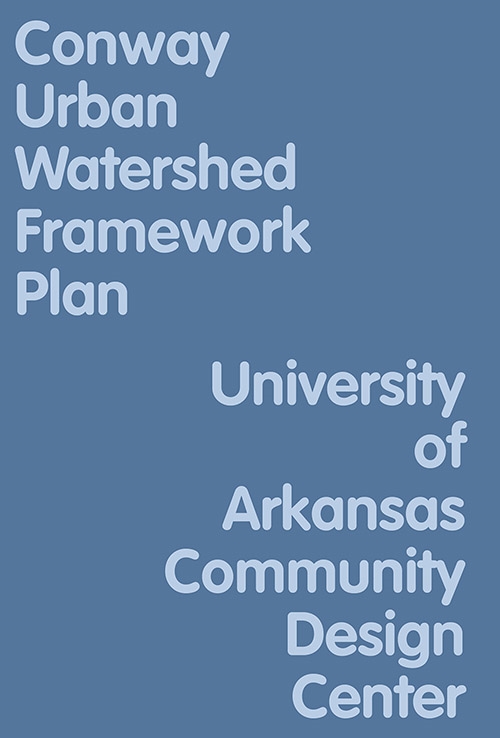
FAYETTEVILLE, Ark. – Two books published by ORO Editions in 2017 highlight projects developed by the University of Arkansas Community Design Center, an outreach program of the Fay Jones School of Architecture and Design.
The books are Conway Urban Watershed Framework Plan and Houses for Aging Socially: Developing Third Place Ecologies. The first fuses ecological engineering and urban design to address the water quality issues of an urban watershed, while the second focuses on the unique housing needs of an aging population.
Both were written and developed under the leadership of Steve Luoni, director of the Community Design Center and the Steven L. Anderson Chair in Architecture and Urban Studies in the Fay Jones School.
Conway Urban Watershed Framework Plan grew from a design project of the same name. The Community Design Center worked with the U of A Office for Sustainability to develop the plan, which addresses the impact of urbanization on the 42-square-mile urban sub-watershed that incorporates much of Conway in Central Arkansas.
Funded in part by a grant from the Environmental Protection Agency, the plan provides city planners and community designers with tools to retrofit a city with green infrastructure and open spaces that reduce the damages from increasingly frequent extreme rainfall events.
Such a plan would have helped the city of Houston and the Gulf Coast of Louisiana weather the effects of extreme flooding and a hurricane last year, Luoni said.
"Considering that city and watershed are distinct systems of flow, generating their own shape and structure across the landscape, how can city form fix the watershed when they occupy the same space?" he said. "City planners focus solely on the human element of design, while environmentalists ignore the issues cities face. We tried to reconcile those extremes in our plan."
The project was an interdisciplinary collaboration between architects, planners, engineers, economists and ecologists. The portfolio of infrastructural elements includes a sponge city gradient, green streets, water treatment art parks, urban eco-farms, conservation neighborhoods, parking gardens, riparian corridor improvements, lake aerators, vegetative harvesters and floating bio-mats, and a city greenway.
The plan won an international LafargeHolcim Acknowledgement Award in October and a 2017 Green Good Design Award for Urban Planning/Landscape Architecture by the European Centre for Architecture Art Design and Urban Studies and The Chicago Athenaeum: Museum for Architecture and Design. It also will be awarded a 2018 Honor Award for Regional and Urban Design by the American Institute of Architects during the AIA Convention and Expo in June.
|
This publication received a 2016-17 Housing Design Education Award from the American Collegiate Schools of Architecture and the American Institute of Architects. |
Houses for Aging Socially: Developing Third Place Ecologies grew from a concern that housing outside the nation's urban centers does not adequately address the mobility, access and social needs of seniors.
"As Baby Boomers turn 65 at the rate of 10,000 per day over the next 20 years, we are finding that both the health care system and housing stock are overwhelmed by the scale of need," Luoni said. "Cooperative forms of living involving pocket neighborhoods, new types of housing fabrics and affordable design keep people in their houses so they don't have to be institutionalized."
The book reworks components of the familiar single-family home to promote new levels of neighborhood connection — allowing residents to live alone but in close proximity to neighbors and friends. Design concepts such as connected hyper-porches, live-work patios and garage galleries used for pop-up businesses foster both neighborhood interaction and independent living.
"A majority of residents in senior homes are there due to social deficits rather than medical problems, as friends or family have moved on or their former homes were simply unaccommodating," Luoni said. "The key is to recombine housing types with care service platforms so that residents can 'age in community' while maintaining some independence."
The book is based on a housing master plan study for the town of Freeman, South Dakota, developed in part in a spring 2016 studio for Fay Jones School students. Funded by an Our Town grant from the National Endowment for the Arts, the project won a 2016-17 Housing Design Education Award from the American Collegiate Schools of Architecture and the American Institute of Architects.
Like all Community Design Center projects, the book uses a specific example to describe a larger transferable planning and design vocabulary that other communities can adapt to their needs, Luoni said.
"We're offering a prototype for policymakers, city planners, designers and others to use," he said. "Both publications give us a vehicle to shape and codify design-based approaches to complex — or 'wicked' — social problems in which design has not yet been fully engaged."
An earlier book, Low-Impact Development: A Design Manual for Urban Areas, has sold more than 7,000 copies and has been translated into Chinese, Luoni said. That book was self-published with EPA funding in 2010.
The two books published by ORO Editions are the center's first foray into work with a traditional publishing company. A third book for ORO, a monograph of Community Design Center work under Luoni's leadership for the past 14 years, is under discussion, he said.
Contacts
Bettina M. Lehovec, communications writer
Fay Jones School of Architecture and Design
479-575-4704, blehovec@uark.edu
Michelle Parks, director of communications
Fay Jones School of Architecture and Design
479-575-4704, mparks17@uark.edu
